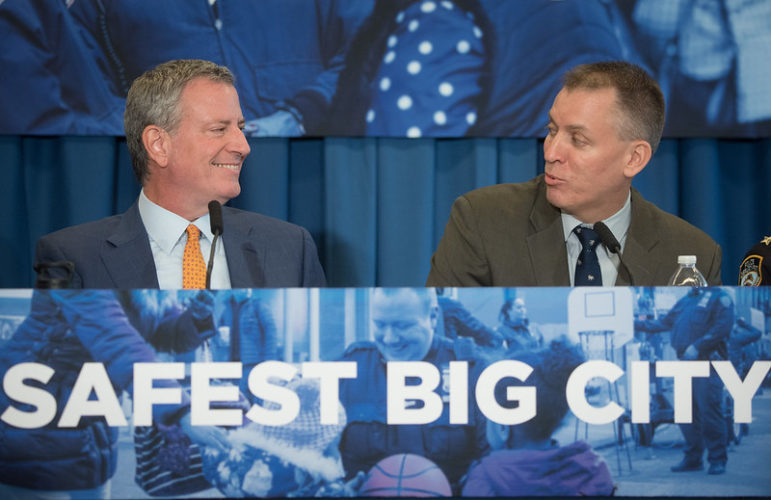Taylonn Murphy Sr. lost his daughter Tayshana to violence between young residents of the Grant and Manhattanville Houses in Harlem in the fall of 2011. Five years later he saw his son, Taylonn Jr., convicted and sentenced to 50 years in prison for murdering a man later in 2011 in what prosecutors depicted as an act of retaliation.
“A lot of people call me Mr. Both Sides of the Gun,” he says.
Taylonn Jr. was swept up with 102 other people in a 2014 East Harlem raid. That raid, and a larger one that occurred two years later in the Bronx, have been the subject for years of a low-profile debate about gang-policing tactics under the de Blasio administration.
As the reported use of “stop and frisk” declined in the last years of the Bloomberg mayoralty and fell even further during Mayor de Blasio’s tenure, the focus of the criminal-justice debate in New York City shifted to “broken windows” policing—a hallmark of de Blasio’s first police commissioner, William Bratton, and a strategy the de Blasio himself steadfastly defended for years. Eventually, broken windows arrests—for fare-beating, public urination, carrying small amounts of marijuana—also began to decline.
But even as stop-and-frisk and “broken windows” were ebbing, the NYPD was beginning to escalate its efforts against gangs or crews. In 2012, the NYPD began implementing “Operation Crew Cut,” which doubled the number of officers in their gang unit, and relauched its “Criminal Group Database” to track alleged gang members. Then came the raids in 2014 and 2016.
Now that gang crackdown is getting new attention, after the release in 2019 of two reports critical of the enforcement strategy and the introduction of a proposed law by City Councilmember Donovan Richards that would require the NYPD to notify minors whose names are in the database and give them a chance to get off.
On Wednesday’s Max & Murphy Show, Murphy Sr. and criminal-justice advocate Josmar Trujillo discussed what they see as the problems with how the city approaches gangs.

Michael Appleton/Mayoral Photography Office
Mayor Bill de Blasio and NYPD Commissioner Dermot Shea hold a crime stat presser at the New Settlement Community Center in the Bronx December 5, 2019.
Asked about the criticism last week on WNYC’s Brian Lehrer Show, de Blasio said he was not sure exactly how names got added to the database, but argued:
… this database is a central tool in addressing a real problem in this city. Even though crime has gone down for six years in a row, the levels of violence are profoundly less than they were in recent years and decades. We have to remain vigilant and we have a huge amount of work to do, and one of the central ongoing problems in this city has been gangs and crews. So, of course we need to have a systematic effort to address that problem. And I just want to say very clearly to the activists and advocates, if you say should we keep assessing if it’s working, should we keep assessing if it’s handled fairly, should we look at ways we can make improvements – of course. But are we going to give up a strategy that is central to stopping gang violence that is afflicting so many neighborhoods? No, we’re not going to do that.
The NYPD contends that gangs and crews are responsible for a disproportionate amount of violent crime. Trujillo acknowledges there is gang violence, but says the police estimates are hard to trust because the NYPD has discretion in whether a crime is considered gang related or not.
“The problem with gangs is overstated. It’s real. There are issues that happen in community. This is not a zero-violence city. This is not a zero-crime city. I think they overstate the problem so they can have an overstated reaction to the problem,” Trujillo says. He believes the increased intensity in gang policing is a political response to the reduction of stop-and-frisk. “‘We’re no longer doing mass unconstitutional arrests. We’re getting the right people.’ But what they’re doing is some of the most abusive policing and prosecutorial tactics that I’ve seen And they’re doing it to a population that they think that can get away doing it to.”
For his part, Murphy sees a need for social intervention to address gang and crew violence. “What I see on the ground is a lack of resources. I think we should make more human investments. I believe if you have credible messengers like myself who are on the ground and understand the community, you can transform some of these young people into something great,” he said.









2 thoughts on “Max & Murphy: NYPD’s Anti-Gang Efforts Under a Microscope”
Trujillo and Murphy: If you want to help people, help them before they commit crimes. Once they’ve committed crimes, it’s up to law enforcement to handle it. Stop treating criminals like snowflakes. Think more about the innocents they have harmed killed, like Tessa Majors. Why do you care about the criminal more than the victim?
But Mr. Johnson, you’re assuming the people they are discussing ARE criminals and HAVE harmed people. Many of the people caught up in the gang raids were not, in the end, alleged to be gang members and many others were not charged with violent crimes. Some were charged with RICO based on older violent crimes to which had already been adjudicated–not new offenses. The whole point is that there is no transparency as to who goes on the Gang Database and who doesn’t.